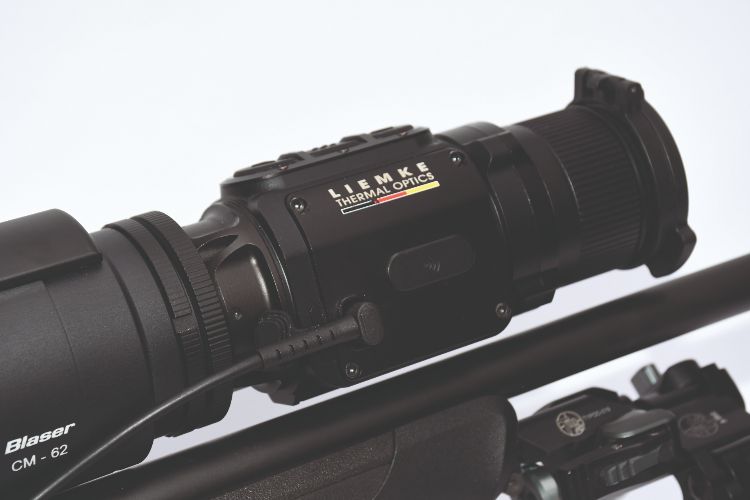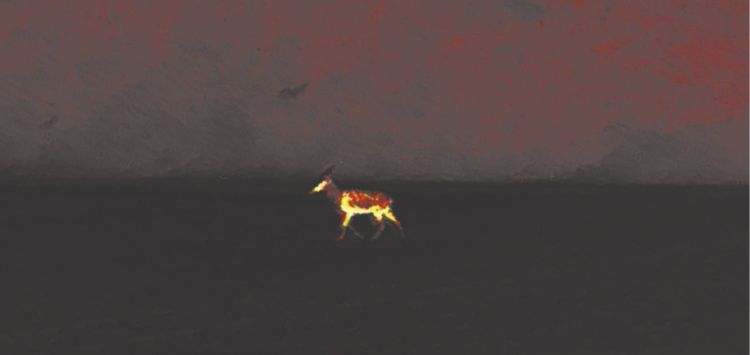Chris Parkin takes a look at a German front-mounted thermal, built for driven boar, that's looking to make its name in Blighty!
Liemke may not be a name you’re overly familiar with, but they have been a major player in the German night vision and thermal scene for quite some time. The company has been fairly recently acquired by the Blaser group, adding that all-important digital edge to a company synonymous with outstanding arms and traditional day optics.
Liemke’s Luchs-1 is a forward/front mounted thermal (FMT) imager that simply clips onto your day scope. It’s available to fit 38mm and 50mm lens sizes, with two collar/adaptor sizes available for 50mm and 56mm objective lenses.
The adaptor is tensioned in place with a quick-release lever that is rubber lined for added grip. Once the initial setup is complete, and the rifle zeroed, the unit can be taken on and off as required with limited (if any) POI shift. Once in installed, it’s controlled with a three-position switch on the left side of the unit that controls power on, off and standby. The latter setting switches off the display to prevent light spillage and minimises power drain from wi-fi and the internal screen.
There’s a USB-C port on the right side for data transfer and charging, which takes about three hours from zero to full. The advertised runtime ranges from 6.5 to 9 hours in typical conditions. There’s a flip-up lens cover and typical focus control up front, and the unit boasts an IP67 rating to cope with any inclement weather.

Initial power up takes around five seconds, after which all the internal functions are controlled with three rubberised buttons up top. These split into up, down and menu access. The menus offer a multitude of functions from digital magnification to selection of one of the five colour palettes – white hot, black hot, extra dark, red hot and rainbow.
All the buttons have dual functionality, with short and long presses used to access the various functions, such as photo or video recording, which are all held securely on 32GB of onboard storage. The menus can also be customised and functions disabled if they are unlikely to be used regularly.
 Left side USB-C charging and data-transfer port
Left side USB-C charging and data-transfer port
All the display icons are shown clearly on screen, and you can set the unit up with unique zeros and settings for up to three riflescopes. As a result, you can really customise things like screen magnification and reticle to suit a particular scope’s field of view.
The zeroing section allows you to correct any minor POI shift between the FMT and your day scope. Screen brightness is adjustable in 10 stages to suit lighting conditions. This can be critical, as your eye relief remains the same in terms of your day scope. Image modes include ‘Sun’, for greater contrast in bright light, and ‘Rain’, which enhances contrast in wet and overcast conditions.
The aspect ratio of the display is relatively square, so you won’t struggle to locate icons tucked away in the corners of the display. Obviously your riflescope will always present a circular field of view, so centralised grouping of the icons is important. It’s worth bearing in mind that zoom applied via www.rifleshootermagazine.co.uk 71 the day scope can obstruct icons, but I didn’t actually find this to be a major problem in the field.
The wi-fi function is simple to use and offers a strong 5m signal with good connectivity to the Liemke app, which includes all the operating instructions as well as providing the option to download recorded footage when you don’t want to transfer files to your computer.
 The Luchs uses a 640×512 sensor with a 12μm pitch, it has a fairly high 50mK NETD but it nevertheless performed well in the field. Not surprisingly, lower magnifications provide the best image quality, as adding zoom via your day scope essentially zooms into the array of pixels on the 640 sensor. This results in a kind of cross-hatching effect within the 1024×768 OLED display. This is typical of all FMT systems and is a major selling point of a larger sensor like this one.
The Luchs uses a 640×512 sensor with a 12μm pitch, it has a fairly high 50mK NETD but it nevertheless performed well in the field. Not surprisingly, lower magnifications provide the best image quality, as adding zoom via your day scope essentially zooms into the array of pixels on the 640 sensor. This results in a kind of cross-hatching effect within the 1024×768 OLED display. This is typical of all FMT systems and is a major selling point of a larger sensor like this one.
The refresh rate is 50Hz, so animal movement is smooth with advertised detection ranges of 1750m for the Luchs-1 and 2500m for the Luchs-2. Both units use an f1.0 objective lens that provides a 22x17.6m and 15.4x12.3m field of view at 100m for the Luchs-1 and Luchs-2 respectively, with focus down to an impressive 2m.
I was impressed by the engineering of the locking collar, which made it easy to set up, remove and reattach without loss of zero. Like all FMTs it’s quite a long reach forward to adjust focus on the unit, so I appreciated the dependable connectivity of the system at arm’s length in what can be a slightly ergonomically compromised arrangement. The controls were tactile and reliable without any latency, and I especially liked the standby mode, which was instantaneous. I didn’t feel that the 580g mass or compact 161x64x65mm design affected portability or handling of the rifle.
CONCLUSION
A forward-mounted thermal imager adds real versatility to a regular daytime hunting rifle. I don’t think they are the ergonomic or visual equal of a dedicated thermal riflescope, but when kept simple and functional like the Liemke they can be an effective tool.
I was particularly impressed by the all-important junction between the thermal and scope, which is often the Achilles’ heel of lesser FMT systems. In countries where it’s illegal to attach a dedicated thermal sight directly, this type of add on is the only option. In the UK, however, long-range pest control and foxing, especially at night, is often the norm. Where the Luchs-1 really excels is on bigger game like wild boar, either driven or at a feeding station.
Small quarry at long ranges requires a very high level of precision, but boar and other larger quarry at closer quarters can be a little more forgiving. It’s in this genre where the Liemke really excels.